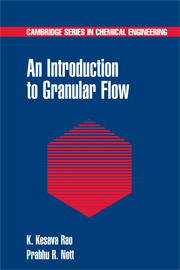Book contents
- Frontmatter
- Contents
- Preface
- Notation
- 1 Introduction
- 2 Theory for Slow Plane Flow
- 3 Flow through Hoppers
- 4 Flow through Wedge-Shaped Bunkers
- 5 Theory for Slow Three-Dimensional Flow
- 6 Flow through Axisymmetric Hoppers and Bunkers
- 7 Theory for Rapid Flow of Smooth, Inelastic Particles
- 8 Analysis of Rapid Flow in Simple Geometries
- 9 Theory for Rapid Flow of Rough, Inelastic Particles
- 10 Hybrid Theories
- Appendix A Operations with Vectors and Tensors
- Appendix B The Stress Tensor
- Appendix C Hyperbolic Partial Differential Equations of First Order
- Appendix D Jump Balances
- Appendix E Discontinuous Solutions of Hyperbolic Equations
- Appendix F Proof of the Coaxiality Condition
- Appendix G Material Frame Indifference
- Appendix H The Evaluation of Some Integrals
- Appendix I A Brief Introduction to Linear Stability Theory
- Appendix J Pseudo Scalars, Vectors, and Tensors
- Appendix K Answers to Selected Problems
- References
- Index
4 - Flow through Wedge-Shaped Bunkers
Published online by Cambridge University Press: 19 November 2009
- Frontmatter
- Contents
- Preface
- Notation
- 1 Introduction
- 2 Theory for Slow Plane Flow
- 3 Flow through Hoppers
- 4 Flow through Wedge-Shaped Bunkers
- 5 Theory for Slow Three-Dimensional Flow
- 6 Flow through Axisymmetric Hoppers and Bunkers
- 7 Theory for Rapid Flow of Smooth, Inelastic Particles
- 8 Analysis of Rapid Flow in Simple Geometries
- 9 Theory for Rapid Flow of Rough, Inelastic Particles
- 10 Hybrid Theories
- Appendix A Operations with Vectors and Tensors
- Appendix B The Stress Tensor
- Appendix C Hyperbolic Partial Differential Equations of First Order
- Appendix D Jump Balances
- Appendix E Discontinuous Solutions of Hyperbolic Equations
- Appendix F Proof of the Coaxiality Condition
- Appendix G Material Frame Indifference
- Appendix H The Evaluation of Some Integrals
- Appendix I A Brief Introduction to Linear Stability Theory
- Appendix J Pseudo Scalars, Vectors, and Tensors
- Appendix K Answers to Selected Problems
- References
- Index
Summary
A bunker is a combination of a bin and a hopper (Fig. 1.5). The abrupt change in geometry at the bin–hopper transition results in a rich variety of flow patterns, and oscillatory wall stresses. These features pose formidable difficulties for modeling bunker flow. At present, there are no satisfactory models which can capture all the observed features.
Some of the experimental observations are summarized below. This is followed by a discussion of models for the bin section, the transition region, and the hopper section.
EXPERIMENTAL OBSERVATIONS
Flow Regimes
The patterns observed by Nguyen et al. (1980) for the flow of sand through a bunker are shown in Fig. 4.1. For θw < 40°, mass flow (type A) occurs regardless of the value of H/W (Fig. 4.2). Here W and H are the half-width of the bunker and the height of the free surface of the material relative to the exit slot, respectively. (For small values of H, the free surface is not flat. In this case, H is the elevation of the point of intersection of the free surface with the bunker wall.) For θw > 70°, funnel flow of type B occurs when H/W exceeds a critical value (≍3) and funnel flow of type C occurs for a smaller value of H/W. As indicated by the hatched regions in Fig. 4.2, the boundaries between various regimes are not sharply defined. For θw = 60°, there is an interesting transition from mass flow to funnel flow, and back again to mass flow as H/W decreases from high values.
- Type
- Chapter
- Information
- An Introduction to Granular Flow , pp. 166 - 212Publisher: Cambridge University PressPrint publication year: 2008
- 1
- Cited by



